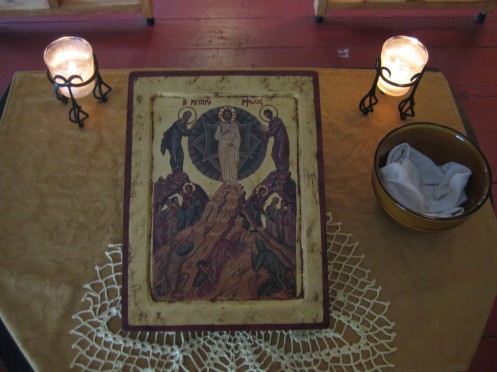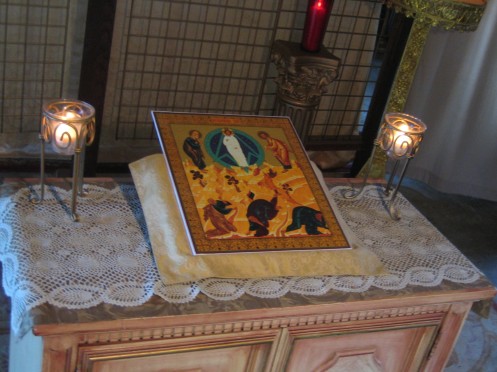By Robert Moynihan
WASHINGTON, D.C., SEPT. 21, 2009 (Zenit.org)- Sometimes there are no fireworks. Turning points can pass in silence, almost unobserved.
It may be that way with the “Great Schism,” the most serious division in the history of the Church. The end of the schism may come more quickly and more unexpectedly than most imagine.
On Sept. 18, inside Castel Gandolfo, the Pope’s summer palace about 30 miles outside Rome, a Russian Orthodox Archbishop named Hilarion Alfeyev, 43 (a scholar, theologian, expert on the liturgy, composer and lover of music), met with Benedict XVI, 82 (also a scholar, theologian, expert on the liturgy and lover of music), for almost two hours, according to informed sources. (There are as yet no “official” sources about this meeting — the Holy See has still not released an official communiqué about the meeting.)
The silence suggests that what transpired was important — perhaps so important that the Holy See thinks it isn’t yet prudent to reveal publicly what was discussed.
But there are numerous “signs” that the meeting was remarkably harmonious.
If so, this Sept. 18 meeting may have marked a turning point in relations between the “Third Rome” (Moscow) and the “First Rome” (Rome) — divided since 1054.
Archbishop Hilarion was in Rome for five days last week as the representative of the new Russian Orthodox Patriarch Kirill of Moscow.
One key person Archbishop Hilarion met with was Cardinal Walter Kasper. On Sept. 17, the cardinal told Vatican Radio that he and Archbishop Hilarion had a “very calm conversation.”
Cardinal Kasper also revealed something astonishing: that he had suggested to the archbishop that the Orthodox Churches form some kind of “bishops’ conference at the European level” that would constitute a “direct partner of cooperation” in future meetings.
This would be a revolutionary step in the organization of the Orthodox Churches.
Papal-Patriarch encounter?
Cardinal Kasper said a Pope-Patriarch meeting was not on the immediate agenda, and would probably not take place in Moscow or Rome, but in some “neutral” place (Hungary, Austria and Belarus are possibilities).
Archbishop Hilarion himself revealed much about how his Rome visit was proceeding when he met on the evening of Sept. 17 (before his meeting with the Pope) with the Community of Sant’Egidio, an Italian Catholic group known for its work with the poor in Rome.
“We live in a de-Christianized world, in a time that some define — mistakenly — as post-Christian,” Archbishop Hilarion said. “Contemporary society, with its practical materialism and moral relativism, is a challenge to us all. The future of humanity depends on our response… More than ever before, we Christians must stand together.”
A report from Interfax, the news service of the Moscow Patriarchate, on Sept. 18 revealed that Archbishop Hilarion spoke to the Pope about “cooperation between the Russian Orthodox and Roman Catholic Churches in the area of moral values and of culture” — in particular during the “Days of Russian Spiritual Culture,” a type of exhibit with lectures scheduled for spring 2010 in Rome. (One might imagine that the Pope himself could attend such an exhibition).
In memory of the visit, Archbishop Hilarion gave the Pope a pectoral cross, made in workshops of Russian Orthodox Church, the report said, Interfax reported.
Today, an Interfax report supplied details of Hilarion’s remarks this morning in the catacombs of St. Callixtus.
“Denied by the world, far from human eyes, deep under ground in caves, the first Roman Christians performed the feat of prayer,” Hilarion said. “Their life brought the fruit of holiness and martyr heroism. The Holy Church was built on their blood shed for Christ.”
Then the Church came out of the catacombs, but Christian unity was lost, the archbishop said.
Archbishop Hilarion said that human sin is the cause of all divisions, while Christian unity can be restored only in the way of sanctity.
“Each of us, conscientiously fulfilling a task the Church has given him or her, is called to personally contribute to the treasury of Christian sanctity and work to achieve God-commanded Christian unity,” the archbishop said.
A second Interfax report today added further information about the meeting with the Pope.
Growing influence
“During a talk with Pope Benedict XVI, Archbishop Hilarion of Volokolamsk pointed out the status of Orthodox believers in Western Ukraine where three Orthodox dioceses had been almost eliminated as a result of coercive actions of Greek Catholics in late 1980s and early 1990s,” Interfax reported.
Archbishop Hilarion “stated the need to take practical steps to improve the situation in Western Ukraine,” within the territories of Lvov, Ternopol and Invano-Frankovsk Dioceses, the report said.
Meanwhile, in Russia itself, the influence of the Russian Orthodox Church, headed by Patriarch Kirill, seems to be growing, though not without opposition.
The rise in Russia of Kirill and his increasing influence in legislative matters seems to be arousing opposition from the “siloviki,” forces connected with the old KGB.
In an article in the current issue of Argumenty Nedeli, Andrey Uglanov says that Kirill’s extraordinary activity has attracted attention from some who do not like to have their positions questioned, let alone challenged. And that has become Kirill’s “big problem.”
These “siloviki,” Uglanov says, have been offended by Kirill’s “anti-Stalinist and anti-Bolshevik actions,” including his appearance at the Solovetsky stone in Moscow’s Lubyanka Square on the very Day of the Memory of the Victims of Political Repression.
In this context, Hilarion’s visit to Rome takes on even more importance.
The Russian Orthodox Church is a power in Russia, but it faces opposition and needs allies.
What is occurring in Hilarion’s visit to Rome, then, may have ramifications not only for the overcoming of the “Great Schism,” but also for the cultural, religious and political future of Russia, and of Europe as a whole.
It is especially significant, in this context, that Hilarion, Kirill’s “Foreign Minister,” has some of the same deep interests as Benedict XVI: the liturgy, and music.
“As a 15-year-old boy I first entered the sanctuary of the Lord, the Holy of Holies of the Orthodox Church,” Hilarion once wrote about the Orthodox liturgy. “But it was only after my entrance into the altar that the ‘theourgia,’ the mystery, and ‘feast of faith’ began, which continues to this very day.
“After my ordination, I saw my destiny and main calling in serving the Divine Liturgy. Indeed, everything else, such as sermons, pastoral care and theological scholarship were centered around the main focal point of my life — the liturgy.”
Liturgy
These words seem to echo the feelings and experiences of Benedict XVI, who has written that the liturgies of Holy Saturday and Easter Sunday in Bavaria when he was a child were formative for his entire being, and that his writing on the liturgy (one of his books is entitled “Feast of Faith”) is the most important to him of all his scholarly endeavors.
“Orthodox divine services are a priceless treasure that we must carefully guard,” Hilarion has written. “I have had the opportunity to be present at both Protestant and Catholic services, which were, with rare exceptions, quite disappointing… Since the liturgical reforms of the Second Vatican Council, services in some Catholic churches have become little different from Protestant ones.”
Again, these words of Hilarion seem to echo Benedict XVI’s own concerns. The Pope has made it clear that he wishes to reform the Catholic Church’s liturgy, and preserve what was contained in the old liturgy and now risks being lost.
Hilarion has cited the Orthodox St. John of Kronstadt approvingly. St. John of Kronstadt wrote: “The Church and its divine services are an embodiment and realization of everything in Christianity… It is the divine wisdom, accessible to simple, loving hearts.”
These words echo words written by Cardinal Ratzinger, now Benedict XVI, who often said that the liturgy is a “school” for the simple Christian, imparting the deep truths of the faith even to the unlearned through its prayers, gestures and hymns.
Hilarion in recent years has become known for his musical compositions, especially for Christmas and for Good Friday, celebrating the birth and the Passion of Jesus Christ. These works have been performed in Moscow and in the West, in Rome in March 2007 and in Washington DC in December 2007.
Closer relations between Rome and Moscow, then, could have profound implications also for the cultural and liturgical life of the Church in the West. There could be a renewal of Christian art and culture, as well as of faith.
All of this was at stake in the quiet meeting between Archbishop Hilarion and Benedict XVI on Friday afternoon, in the castle overlooking Lake Albano.




